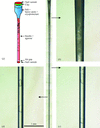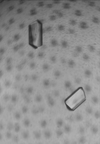issue contents
July 2002 issue

Cover illustration: Insulin crystals grown in a restricted geometry by counter-current diffusion allow the consolidation of the three principal steps of crystal growth optimization, cryogenic X-ray data collection and ab initio phase determination into one for rapid structure determination without crystal manipulation, p.1147.
research papers
The crystal structure of the high-potential iron–sulfur protein from T. tepidum was refined using low-temperature diffraction data to 0.80 Å resolution collected using synchrotron radiation. The electron transfer is discussed based on the hydrophobic interaction and molecular packing.
PDB reference: HiPIP, 1iua, r1iuasf
Using lysozyme and Fc receptor crystals as test cases, it was demonstrated that conventional heavy-atom derivatives could be generated by quick soaking in a 10 min to 2 h time frame instead of days. Derivatives generated in this way showed stronger heavy-atom signals and appeared to be more isomorphous to the native than derivatives generated by overnight soaks.
A quick-soak method was used to generate heavy-atom derivatives for the de novo phasing of two structures. The derivatives generated this way were not only sufficient for phasing, but were also better diffracting and more isomorphous to the natives than derivatives soaked overnight.
An isoform of cytochrome c6 from the cyanobacterium A. maxima crystallized in space group I4132, with eight molecules in the asymmetric unit. The crystal structure reveals protein molecules packed into hollow clusters of 24 molecules.
PDB reference: cytochrome c6, 1kib, r1kibsf
A thiol-reactive lanthanide chelate was used to incorporate ordered dysprosium ions into crystals of a 34 kDa test protein. Data collected from these crystals in-house and at a synchrotron beamline possessed a large anomalous signal, which enabled calculation of high-quality SAD phases in both cases.
The high-resolution crystal structure of a snake-venom metalloproteinase (SVMP), TM-3, was solved, which appears to have a stronger resemblance among the known structures of SVMP to the crystal structure of catalytic domain of TNF-converting enzyme (TACE).
PDB reference: TM-3, 1kuf, r1kufsf
The crystal structure of a hypothetical RNA 2′-O-ribose methyltransferase from T. thermophilus (RrmA) has been determined at 2.4 Å resolution and a deep trefoil knot has been found for the first time.
PDB reference: T. thermophilus RrmA, 1ipa, r1ipasf
An atomic resolution structure of the NAD+ synthetase is presented with implications for the catalytic mechanism.
PDB reference: NAD+ synthetase, 1kqp, r1kqpsf
The crystallization, cryoprotection and heavy-atom derivatization of insulin have been optimized using the counter-diffusion technique in a restricted geometry. The protein crystals obtained were immediately used for in situ X-ray diffraction, phase determination by SAS and electron-density map calculation without crystal manipulation.
The structure analysis of high-salt crystals of oxy- and deoxyhaemoglobin at different levels of environmental humidity and solvent content appears to indicate that the deoxy form can access an ensemble of related T states.
A comparative study involving monoclinic lysozyme crystals grown in the presence of sucrose, trehalose, sorbitol and glycerol suggests that the stabilizing additives have no significant effect on the structure of the enzyme and the organization of the ordered water molecules around it.
PDB references: lysozyme, native monoclinic (I), 1lj3, r1lj3sf; native monoclinic (II), 1lj4, r1lj4sf; with 10% sucrose (I), 1lje, r1ljesf; with 10% sucrose (II), 1ljf, r1ljfsf; with 5% glycerol (I), 1ljg, r1ljgsf; with 5% glycerol (II), 1ljh, r1ljhsf; with 10% sorbitol, 1lji, r1ljisf; with 10% trehalose, 1ljj, r1ljjsf; with 15% trehalose, 1ljk, r1ljksf
The crystal structure of B. subtilis lipase was determined at 1.3 Å resolution. A substrate-binding model is proposed on the basis of the presence of alternate conformations in the side chain of the catalytic serine residue and a glycerol molecule in the active site.
PDB reference: lipase, 1isp, r1ispsf
As an important step in understanding the interactions between the pollen protein and components of the human immune system, the structure of the C-terminal key domain of the major allergen Phlp 5b from timothy grass pollen has been determined at 2.0 Å. It is the first known allergen composed entirely out of α-helices.
PDB reference: [Phlp 5b]′, 1l3p
The X-ray crystal structure of the proform of human matrix metalloproteinase MMP9 has been solved to 2.5 Å resolution. The design of MMP9 inhibitors may be able to exploit the shape of the S1′ binding pocket for specificity.
PDB reference: human ProMMP9, 1l6j, r1l6jsf
crystallization papers
Crystals of carnitine acetyltransferase are reported to diffract X-rays to 1.6 Å resolution. This enzyme catalyzes the transfer of short-chain acyl groups to CoA.
The first soluble recombinant class I HLA-A*1101 molecule has been expressed and refolded in vitro with β2-microglobulin and a Nef decapeptide. The complex was crystallized and X-ray diffraction data to 2.2 Å resolution were collected.
Mutations and deliberate oxidation of the protein have been used to enhance the possibilities of experimental phasing. The variant protein crystallized under different conditions to the wild-type protein and produced a crystal form of increased physical stability.
A 154-residue mini-intein from the dnaB gene of Synechocystis sp. PCC 6803 (Ssp DnaB intein) has been purified and crystallized using PEG 4000 as a precipitant.
A naturally occurring split intein from the dnaE gene of Synechocystis sp. PCC6803 (Ssp DnaE intein) has been purified and crystallized using PEG 8K as precipitant.
Crystallization and preliminary analysis of the substrate-sensor protein ClpS from E. coli alone and in complex with the N-terminal substrate-binding domain of ClpA is reported.
Rat ecto-ADP-ribosyltransferase (ART2.2) has been expressed in the periplasm of E. coli, purified and crystallized in three forms diffracting to high resolution.
Various truncations of the extracellular domain of human TGF-β receptor have been expressed for crystallizations. Among them, TBRII (27-136)yielded crystals diffracting to 1.05 Å resolution.
A yedU gene product with a molecular mass of 31 kDa is a hypothetical protein with no known function. The protein was purified and crystallized at 296 K.
Nickel-containing superoxide dismutase belongs to a new class of superoxide dismutases. It has been crystallized in various crystal forms and initial phase information has been obtained by MAD at the Ni K edge.
Crystals of E. coli IscS were prepared, and a native X-ray diffraction data set was obtained to a resolution of 2.1 Å.
Vancomycin is the last line of defence in the treatment of Gram-positive infection. It is a complex molecule composed of carbohydrate and cyclized peptides. The crystallization of dTDP-3-amino-4-keto 2,3,6-trideoxy-3-C-methyl-glucose-5-epimerase, an enzyme involved in the synthesis of the carbohydrate portion of the compound, is reported.
The eukaryotic pore-forming toxin sticholysin II has been crystallized by the hanging-drop vapour-diffusion method. Native data have been collected to 1.71 Å resolution.
A thermostable monoacylglycerol lipase from the moderately thermophilic Bacillus sp. H-257 has been crystallized. Diffraction data have been collected to 2.6 A resolution.
RNase P protein from T. maritima was overexpressed in E. coli, purified and crystallized. Crystals diffract beyond 2.0 Å, belong to the monoclinic space group P21 and have unit-cell parameters a = 56.29, b = 64.41, c = 68.19 Å, β = 101.94°.
The crystallization and preliminary X-ray diffraction analysis of K. pneumoniae acetolactate synthase is reported. This enzyme is involved in the formation of 2-acetolactate which is the precursor of the branched-chain amino acids valine and leucine.
small DNA-binding protein of 87 amino-acid residues from the hyperthermophilic archaeon M. jannaschii (Mja10b) has been cloned and overexpressed in Escherichia coli.
A protein of unknown function, YodA, from E. coli was purified and crystallized in several different crystal forms.
The complex formed between PfMSP1-19, a promising malaria vaccine candidate, and the Fab of a specific monoclonal antibody has been crystallized. A preliminary model of the complex has been determined by molecular replacement.
The response regulator DivK was crystallized in space group P212121, with unit-cell parameters a = 37.2, b = 40.5, c = 67.1 Å. Native data have been collected at 1.6 Å resolution.
short communications
Anisotropic analysis of the C-term fragment of human collagen shows a high degree of libration in secondary structures at 100 K.
PDB reference: collagen Kunitz-type domain, 1kth


 journal menu
journal menu



















































